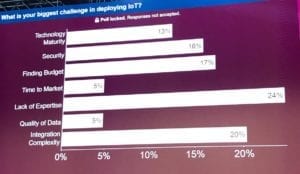At the 2017 IoT World Forum yesterday, Cisco said 60% of IoT projects fail in infancy/Proof of Concept (POC) stage and only 26% actually get completed. While this may sound alarming, it doesn’t surprise me much as I remember in the early days of cloud computing, we saw similar adoption trends. And these numbers may not be so bad considering IoT is even more complex than what cloud computing was in the early stages. Cloud was mostly about doing stuff that you would normally do but on someone else’s computer which is remote from you. It was disruptive but to an extent cloud was a shift from one computing model to another and arguably a more efficient model.
IoT on the other hand specially on the commercial side is a fundamental change from how we design and develop products, manufacture things, use them and improve their lifecycle, drive savings, develop new business models and increase revenue and profits. IoT is not just disruptive like cloud but depending on how much legacy you have, the impact will be multiple times. It is probably safe to say, it can be as disruptive as the internet itself.
The encouraging news in Cisco’s data is that companies are actually investing in IoT. So, clearly they see potential value however the success rate for projects is still very low. We can’t let three quarters of IoT projects fail!
The TwitterSphere has been blazing with this information and more. In a Live Poll, Cisco asked attendees what they felt the top challenges for IoT were. I am thankful to Cisco for raising awareness on this topic. See below results :

Integration Complexity emerged at the top and is clearly a pain point that IoT’ers are seeing at the Edge/Fog level. But Integration Complexity also needs to be overcome at the cloud and data analytics level. There are a plethora of technologies available from established and startup companies – the challenge is in selecting the right ones to build and scale IoT solutions. I also found ‘Lack of Expertise’ at 24% as a real concern as without right people, it is simply not possible to implement a solid IoT solution. By right, I mean people who have IT and Operational Management understanding and experience – and this applies to strategy, product management, business development and technical professionals. One of the premises of my company Dihuni is to address skillset gaps that are slowing down adoption of IoT. I also feel thinking about IoT in isolation is a mistake. As enterprises decide to invest in IoT, they should expand their view and build their strategy on complete Digital Transformation – have clear goals and implement in small chunks. Failure is fine but only if it is fast and with the purpose of trying again until you succeed.
How to Succeed with IoT and Digital Transformation?
As Chuck Robbins emphasized in his keynote, we need to find ways to go beyond 26% success rate. At Dihuni, we want to help you in your quest for success with IoT as well as complete Digital Transformation. Our job is to make sure your IoT and Digital Transformation projects succeed – period. Some recommendations for success revolve around the following areas:
- Know what problems you are solving for
- Get Right Skillset to Develop Clear Digital Strategy and Product Management, Marketing and Go to Market
- Right-sized back-end On-Premise or Cloud Infrastructure : servers, storage or IaaS services or OEM optimized hardware
- Select right edge to cloud IoT technologies
- Develop Enterprise SaaS and cross-platform iOS and Android Mobile Applications
- Effective Digital Marketing including integrated multi-channel and social media strategy and implementation
We would love to hear from you about your IoT or other Digital Transformation project and experience. Please e-mail us at digital@dihuni.com or you can also call us at the number on our Contact Us page.

